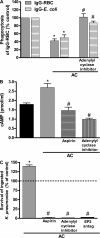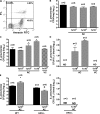Efferocytosis impairs pulmonary macrophage and lung antibacterial function via PGE2/EP2 signaling
- PMID: 19124657
- PMCID: PMC2626688
- DOI: 10.1084/jem.20082058
Efferocytosis impairs pulmonary macrophage and lung antibacterial function via PGE2/EP2 signaling
Abstract
The ingestion of apoptotic cells (ACs; termed "efferocytosis") by phagocytes has been shown to trigger the release of molecules such as transforming growth factor beta, interleukin-10 (IL-10), nitric oxide, and prostaglandin E(2) (PGE(2)). Although the antiinflammatory actions of these mediators may contribute to the restoration of homeostasis after tissue injury, their potential impact on antibacterial defense is unknown. The lung is highly susceptible to diverse forms of injury, and secondary bacterial infections after injury are of enormous clinical importance. We show that ACs suppress in vitro phagocytosis and bacterial killing by alveolar macrophages and that this is mediated by a cyclooxygenase-PGE(2)-E prostanoid receptor 2 (EP2)-adenylyl cyclase-cyclic AMP pathway. Moreover, intrapulmonary administration of ACs demonstrated that PGE(2) generated during efferocytosis and acting via EP2 accounts for subsequent impairment of lung recruitment of polymorphonuclear leukocytes and clearance of Streptococcus pneumoniae, as well as enhanced generation of IL-10 in vivo. These results suggest that in addition to their beneficial homeostatic influence, antiinflammatory programs activated by efferocytosis in the lung have the undesirable potential to dampen innate antimicrobial responses. They also identify an opportunity to reduce the incidence and severity of pneumonia in the setting of lung injury by pharmacologically targeting synthesis of PGE(2) or ligation of EP2.
Figures





Similar articles
-
Efferocytosis-induced prostaglandin E2 production impairs alveolar macrophage effector functions during Streptococcus pneumoniae infection.Innate Immun. 2017 Apr;23(3):219-227. doi: 10.1177/1753425916684934. Epub 2016 Dec 20. Innate Immun. 2017. PMID: 28359217
-
Prostaglandin E2 inhibits alveolar macrophage phagocytosis through an E-prostanoid 2 receptor-mediated increase in intracellular cyclic AMP.J Immunol. 2004 Jul 1;173(1):559-65. doi: 10.4049/jimmunol.173.1.559. J Immunol. 2004. PMID: 15210817
-
E-prostanoid 3 receptor deletion improves pulmonary host defense and protects mice from death in severe Streptococcus pneumoniae infection.J Immunol. 2009 Aug 15;183(4):2642-9. doi: 10.4049/jimmunol.0900129. Epub 2009 Jul 27. J Immunol. 2009. PMID: 19635910 Free PMC article.
-
Prostaglandin E2 modulation of blood pressure homeostasis: studies in rodent models.Prostaglandins Other Lipid Mediat. 2011 Nov;96(1-4):10-3. doi: 10.1016/j.prostaglandins.2011.07.001. Epub 2011 Jul 27. Prostaglandins Other Lipid Mediat. 2011. PMID: 21801847 Free PMC article. Review.
-
Efferocytosis and lung disease.Chest. 2013 Jun;143(6):1750-1757. doi: 10.1378/chest.12-2413. Chest. 2013. PMID: 23732585 Free PMC article. Review.
Cited by
-
Obesity impairs apoptotic cell clearance in asthma.J Allergy Clin Immunol. 2013 Apr;131(4):1041-7, 1047.e1-3. doi: 10.1016/j.jaci.2012.09.028. Epub 2012 Nov 13. J Allergy Clin Immunol. 2013. PMID: 23154082 Free PMC article.
-
Modulation of macrophage efferocytosis in inflammation.Front Immunol. 2011 Nov 8;2:57. doi: 10.3389/fimmu.2011.00057. eCollection 2011. Front Immunol. 2011. PMID: 22566847 Free PMC article.
-
Impaired PPARγ activation by cadmium exacerbates infection-induced lung injury.JCI Insight. 2023 May 8;8(9):e166608. doi: 10.1172/jci.insight.166608. JCI Insight. 2023. PMID: 36928191 Free PMC article.
-
Prostaglandin E2 Receptor 2 Modulates Macrophage Activity for Cardiac Repair.J Am Heart Assoc. 2018 Oct 2;7(19):e009216. doi: 10.1161/JAHA.118.009216. J Am Heart Assoc. 2018. PMID: 30371325 Free PMC article.
-
IL-10 administration reduces PGE-2 levels and promotes CR3-mediated clearance of Escherichia coli K1 by phagocytes in meningitis.J Exp Med. 2010 Jun 7;207(6):1307-19. doi: 10.1084/jem.20092265. Epub 2010 May 24. J Exp Med. 2010. PMID: 20498022 Free PMC article.
References
-
- Wheeler, A.P., and G.R. Bernard. 2007. Acute lung injury and the acute respiratory distress syndrome: a clinical review. Lancet. 369:1553–1564. - PubMed
-
- Fadok, V.A., D.L. Bratton, A. Konowal, P.W. Freed, J.Y. Westcott, and P.M. Henson. 1998. Macrophages that have ingested apoptotic cells in vitro inhibit proinflammatory cytokine production through autocrine/paracrine mechanisms involving TGF-beta, PGE2, and PAF. J. Clin. Invest. 101:890–898. - PMC - PubMed
-
- Voll, R.E., M. Herrmann, E.A. Roth, C. Stach, J.R. Kalden, and I. Girkontaite. 1997. Immunosuppressive effects of apoptotic cells. Nature. 390:350–351. - PubMed
-
- McDonald, P.P., V.A. Fadok, D. Bratton, and P.M. Henson. 1999. Transcriptional and translational regulation of inflammatory mediator production by endogenous TGF-beta in macrophages that have ingested apoptotic cells. J. Immunol. 163:6164–6172. - PubMed
Publication types
MeSH terms
Substances
Grants and funding
LinkOut - more resources
Full Text Sources
Other Literature Sources
Molecular Biology Databases

